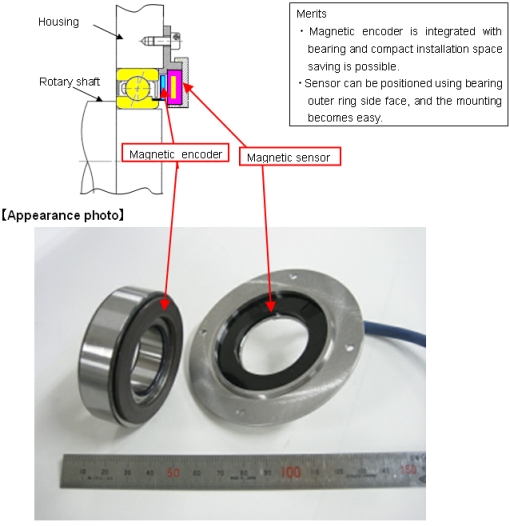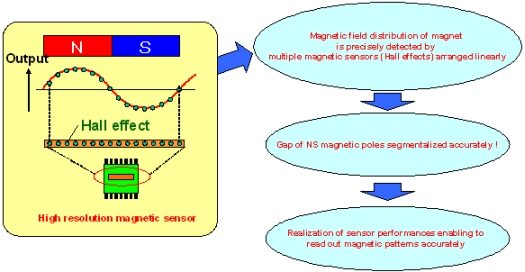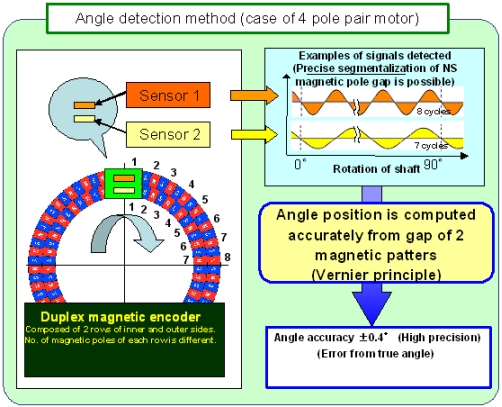
Development of ‘High Precision Magnetic Angle Sensor’ Enabling Advanced Control of MotorsApril 28, 2010
NTN Corporation (hereafter NTN) has developed a magnetic angle sensor with the capability of detecting the rotational position (rotational angle) of the rotary shaft with high accuracy by combining the magnetic encoder and the magnetic sensor. The magnetic encoder is integrated in bearing, and saves space as well as making it easier to mount while maintaining the high precision of the magnetic sensor.
In drive motors, such as for electric vehicles and electric power steering motors, the motor current is precisely controlled according to the rotational positions of the rotor to enhance energy efficiency. Angle sensors are required to detect rotational positions of rotors accurately. For environments with vibration and contamination, magnetic sensors, or resolvers*1 are used. However, when resolvers are applied, signal processing circuits have to be prepared separately. Most angle sensors using magnetic sensors measure at the ends of rotary shafts. Because of this, high precision angle sensors mounted on the outer circumference of the rotary shafts for measurement were not feasible.
Advantages of this new product are as follows:
- Compact setup of the entire sensor in an axial space of 8mm or less adjacent to the bearing is possible by integrating a magnetic encoder with the bearing rotary ring. This allows for size and weight reduction.
- Stabilized high precision angle detection (angle accuracy: ±0.4° or less) and applicable to drive motors etc. for electric vehicles.
- Capable of corresponding to high speed revolutions (Max. number of revolutions: is 15,000rpm, when using 24 pole pair magnetic encoder) and applicable to drive motors of electric vehicles. If the number of pole pairs of the magnetic encoder is decreased, it is possible to read to 15,000rpm or more.
- A Signal processing circuit is integrated, and the additional processing circuit required in the case of the resolver, is unnecessary, thus the system can be simplified.
This product detects angles by mounting a ring shaped magnetic encoder widely used for automotive wheel speed sensors, on a rotating body. This rotating body is then combined with a magnetic sensor fit to the non-rotational component . Magnetic patterns of two rows with a different number of magnetic poles are formed on the magnetic encoder. When magnetic patterns of two rows are read with two independent magnetic sensors, the gap between the two signals changes depending on the rotational position. The rotational position (angle) is measured accurately using the vernier principle*2 based on the amount of gap. The magnetic sensor requires performances to read out magnetic patterns accurately and high resolution magnetic sensor technology jointly developed with SNR (France) is applied to the sensor.
NTN will market this new product mainly for automotive motors.
*1 ‘Resolver’: Detects angles by using electromagnetic induction generated from coils of rotor and stator
*2 ‘Vernier principle’: Vernier. Device to read fraction in one scale of basic scale. This principle is used for read out devices such as verniers.
Features
- Angle accuracy : ±0.4° or less (High precision)
- Max. number of revolutions : 15000rpm (when 24 pole pair magnetic encoder is used) → Applicable to EV drive motors
- Signal processing circuit integrated : No external processing circuit is required
- Compact : Contribute to down sizing of equipments
- Possible to install on outer circumference of rotational shaft
Applications
Motor control sensors for automotives and industrial equipment
Inquiries about this release
Explanation
(1) Example of actual mounting: Combination with bearing

(2) High resolution magnetic sensor technology jointly developed with SNR (France)

(3) Angle detection method (case of 4 pole pair motor)

Output of optimum angle information is made possible by setting the combination of number of magnetic poles of two rows formed on magnetic encoder in accordance with a motor used.
Example:In case of 4 pole pair motor, set number of magnetic pole pairs of magnetic encoder to 32 and 28.
⇒ Magnetic encoder poles of 8 pairs and 7 pairs are set in the range of 90°.
